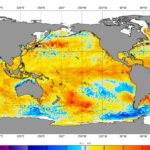A new study suggests that the current classification system for hurricanes may need to be revised to better reflect the increasing strength and destructiveness of storms caused by climate change. The research, published in the Proceedings of the National Academy of Sciences, questions whether the existing Saffir-Simpson Hurricane Wind Scale, which ranks hurricanes from 1 to 5 based on their maximum sustained wind speed, is sufficient to communicate the dangers of more intense storms.
The study argues that the open-endedness of the Saffir-Simpson Scale can lead to an underestimation of the risks posed by hurricanes, especially in a warming world. The researchers propose adding a Category 6 to the scale to better convey the damaging wind speeds associated with these more intense storms.
Currently, Category 1 on the scale describes wind speeds of 74 to 95 mph, while Category 5 is reserved for storms with wind speeds of 158 mph or greater. However, the study found that five storms in the last nine years had peak winds greater than 192 mph, suggesting that they could have been classified as Category 6 storms.
Multiple studies have shown that while climate change is not expected to increase the number of hurricanes, it will lead to stronger storms. Warmer ocean temperatures and a warmer atmosphere, which can hold more moisture, contribute to the intensification of hurricanes. This means that as long as global warming continues, the planet can expect more intense storms with heavier rainfall and catastrophic flooding.
The study also used models to examine how different climate scenarios could affect hurricanes, finding that a 2-degree Celsius increase in global temperatures could double the risk of Category 6 storms in the Gulf of Mexico and other regions prone to strong hurricanes, such as Southeast Asia and the Philippines.
The findings highlight the need to better communicate the threats of extreme weather events and the ways in which climate change can amplify them. The Saffir-Simpson scale has been criticized for failing to convey some of the most destructive aspects of hurricanes, such as storm surge, rainfall, and flooding. While adding a Category 6 to the scale may not solve this issue, it could raise awareness about the increased risk of major hurricanes due to global warming.
In response to these concerns, the National Hurricane Center announced that it will begin issuing a new experimental forecast this summer for tropical storms. The updated forecasts will include inland tropical storm and hurricane watches and warnings to better convey the inland wind risks during extreme weather events.
Overall, the study underscores the need for a reevaluation of how hurricanes are classified in order to accurately convey their growing intensity and the risks they pose in a warming world.



